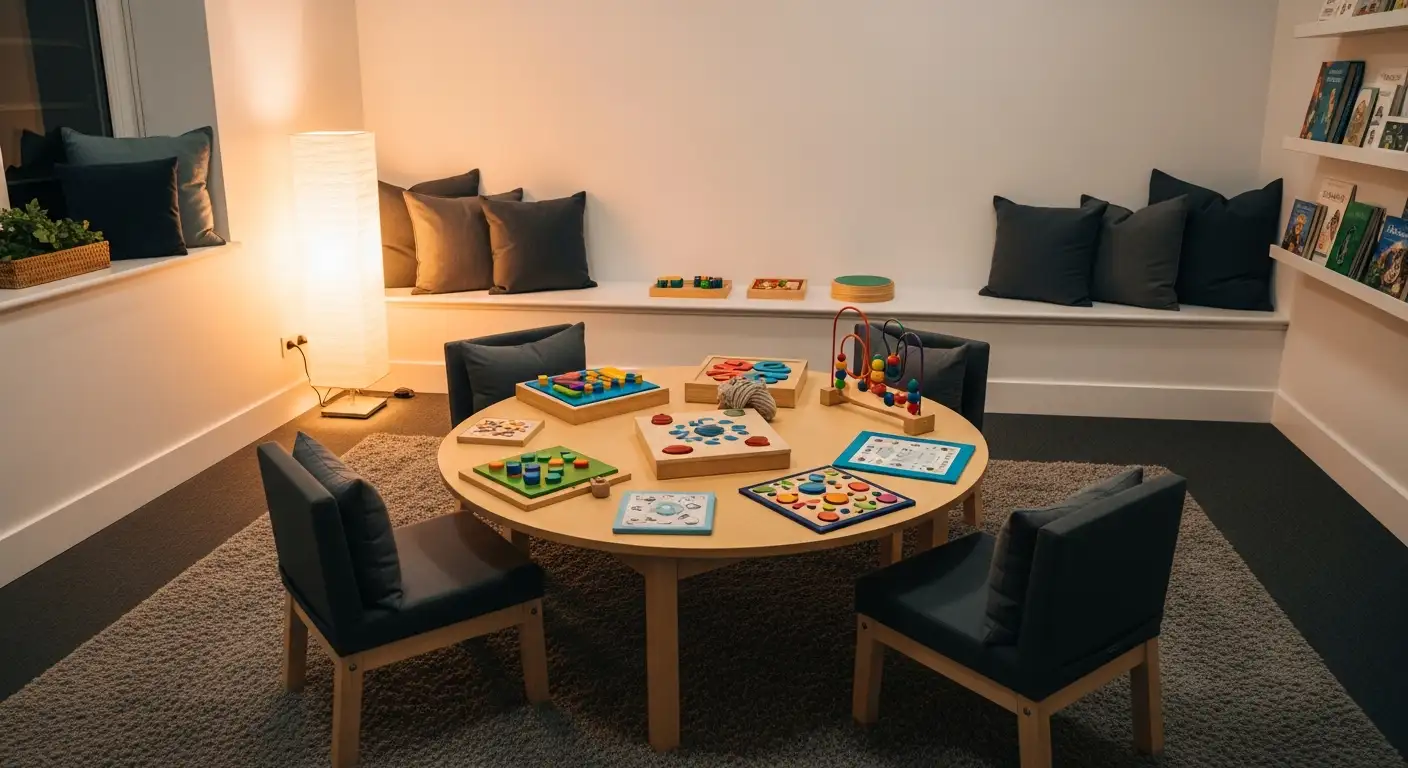
Understanding ABA Therapy
ABA therapy, or Applied Behavior Analysis therapy, has been a key approach in helping children with autism and related developmental disorders since the 1960s. This evidence-based treatment focuses on teaching and developing skills that improve behaviors and increase independence. ABA therapy is particularly effective when implemented as an early intervention approach, allowing children to acquire essential skills for lifelong success.
History of ABA Therapy
The history of ABA therapy dates back to the pioneering work of behavior analysts, such as Dr. Ivar Lovaas, who conducted groundbreaking research on behavior modification techniques for individuals with autism. Lovaas's studies laid the foundation for the development of ABA therapy as a systematic and effective approach to address the unique needs of individuals with autism.
Since then, ABA therapy has continued to evolve, with researchers and practitioners refining and expanding its techniques and applications. Today, ABA therapy is widely recognized as an evidence-based best practice treatment for autism, endorsed by the US Surgeon General and the American Psychological Association [1].
Key Players in ABA Therapy
ABA therapy programs are typically overseen by a board-certified behavior analyst (BCBA), who plays a crucial role in designing and customizing treatment plans for individuals with autism. The BCBA assesses the learner's skills, needs, interests, preferences, and family situation, and sets individual goals based on their age and ability level.
Therapists, also known as registered behavior technicians (RBTs), are an integral part of ABA therapy programs. They work directly with children and adults with autism to implement the treatment plan developed by the BCBA. RBTs receive training and supervision from the BCBA to ensure the effective delivery of ABA techniques and interventions.
The collaboration between the BCBA and the therapists is essential for the successful implementation of ABA therapy. Together, they create a supportive and structured environment for individuals with autism to practice skills, make progress, and achieve their goals.
ABA therapy's effectiveness has been demonstrated by more than 20 studies, and it is considered an evidence-based best practice treatment for individuals with autism. By understanding the history and key players in ABA therapy, parents can make informed decisions about pursuing this beneficial intervention for their children. For more information on ABA therapy and its various components, continue reading our article.

Benefits of ABA Therapy
ABA therapy, also known as Applied Behavior Analysis, has been recognized as the "gold standard" of autism treatments due to its effectiveness and long-term impact. Numerous studies have shown that children who undergo ABA therapy demonstrate significant improvements in their ability to lead independent lives and meet developmental milestones. In this section, we will explore two key benefits of ABA therapy: improvements in intellectual functioning and gains in language development.
Improvements in Intellectual Functioning
ABA therapy has been proven to have positive effects on intellectual functioning in children with autism spectrum disorder (ASD). Long-term, comprehensive ABA-based interventions have shown positive medium to large effects in intellectual functioning, as indicated by standardized mean differences.
Studies have demonstrated that intensive and long-term ABA therapy programs, consisting of 25 to 40 hours per week for 1 to 3 years, can lead to significant gains in intellectual functioning. These gains include improvements in cognitive abilities, problem-solving skills, and overall intellectual capabilities. The structured and individualized nature of ABA therapy allows for targeted intervention and the development of essential cognitive skills in children with ASD.
Gains in Language Development
Language development is another area where ABA therapy has shown remarkable benefits for children with autism. ABA-based interventions have been associated with improvements in communication skills, expressive language, and socialization.
Research has indicated that children who receive ABA therapy experience significant progress in their ability to communicate effectively. This progress includes enhanced vocabulary development, improved speech articulation, and increased social interaction skills. ABA therapy utilizes various techniques, such as discrete trial training and natural environment teaching, to facilitate language acquisition and foster meaningful communication.
By targeting specific language goals and providing intensive and individualized interventions, ABA therapy helps children with ASD overcome communication challenges and develop the necessary skills to express themselves effectively.
In addition to these benefits, ABA therapy offers a comprehensive approach to addressing various aspects of autism, including social skills, daily living skills, and behavioral challenges. By tailoring interventions to the unique needs of each child, ABA therapy aims to improve overall quality of life and promote positive outcomes for individuals with autism.
In the next sections, we will further explore the components of ABA therapy and the techniques used to support skill development and generalization.

Components of ABA Therapy
ABA therapy is a comprehensive and individualized approach to supporting individuals with autism spectrum disorder (ASD). It involves various components that work together to promote skill development and improve behavior. Two key components of ABA therapy are the role of the Board Certified Behavior Analyst (BCBA) and the involvement of therapists and Registered Behavior Technicians (RBTs).
Role of BCBA in ABA Programs
The BCBA plays a crucial role in ABA programs, designing and directly overseeing the therapy to meet the specific needs of each learner. They are highly trained professionals who possess expertise in behavior analysis and are certified by the Behavior Analyst Certification Board. The BCBA collaborates with the individual with ASD, their family, and other professionals to develop individualized treatment goals based on the person's age, ability level, and specific needs.
The BCBA conducts thorough assessments, such as functional behavior assessments, to identify target behaviors and develop behavior intervention plans. They also design and implement data-driven interventions, monitor progress, and make necessary adjustments to the therapy program to ensure its effectiveness. The BCBA provides ongoing training and supervision to therapists and RBTs to ensure the treatment plan is implemented correctly and consistently.
Involvement of Therapists and RBTs
Therapists and RBTs play a hands-on role in delivering ABA therapy to individuals with ASD. They work directly with the individuals to practice skills and work towards the goals set by the BCBA. Therapists and RBTs are trained and supervised by the BCBA to ensure that the therapy is delivered in a consistent and effective manner.
RBTs, in particular, have an important role in implementing treatment and behavior plans. They work closely with the individuals to teach and reinforce skills, collect data on progress, and assist in managing challenging behaviors. RBTs must follow the behavior intervention plans developed by the BCBA, which are based on the results of functional behavior assessments.
The involvement of therapists and RBTs is essential for the success of ABA therapy. They provide direct support and guidance to individuals with ASD, helping them acquire new skills, reduce problem behaviors, and maximize their potential for independence and success.
By working together, the BCBA, therapists, and RBTs create a collaborative and effective ABA therapy team. The BCBA's expertise and oversight, combined with the dedication and skill of the therapists and RBTs, ensure that individuals with ASD receive the individualized and evidence-based intervention they need to thrive.
ABA Therapy Techniques
ABA therapy utilizes various techniques to support skill acquisition and promote positive behavioral changes in individuals with autism. Two key techniques commonly employed in ABA therapy are the seven dimensions of ABA and task analysis with skill breakdown.
Seven Dimensions of ABA
ABA therapy focuses on seven core concepts known as the seven dimensions of ABA. These dimensions include:
- Generalization: Promoting the application of learned skills across different settings, people, and situations to ensure skills are not limited to specific contexts.
- Effective: Utilizing interventions that are evidence-based and proven to be effective in promoting positive behavior change.
- Technological: Applying techniques that are well-defined and replicable to ensure consistent treatment delivery.
- Applied: Addressing socially significant behaviors and teaching skills that have practical value and relevance in the individual's daily life.
- Conceptually Systematic: Utilizing a systematic approach to analyze behavior and design interventions based on the principles of behavior analysis.
- Analytic: Utilizing data collection and analysis to evaluate the effectiveness of interventions and make data-driven decisions.
- Behavioral: Focusing on observable and measurable behavior changes to track progress and determine the effectiveness of interventions.
By integrating these dimensions into ABA therapy, practitioners ensure that children with autism receive treatment based on meaningful research and effective strategies. For more information on specific ABA therapy techniques, refer to our articles on ABA therapy for behavioral interventions and ABA therapy and inclusion strategies.
Task Analysis and Skill Breakdown
Task analysis plays a crucial role in ABA therapy. It involves breaking down complex activities or skills into smaller, more manageable steps. This systematic breakdown allows for a gradual and achievable progression, ensuring that children experience success at each stage of skill acquisition.
The process of task analysis is based on the principle that mastering individual components of a skill paves the way for more advanced learning. By teaching each step of the task individually and systematically, children with autism can build confidence and competence in the targeted skill areas.
Within task analysis, skill breakdown refers to breaking down a specific skill into its component steps. This breakdown enables therapists to teach the skill systematically, providing clear instructions and reinforcement for each step. Prompting techniques, such as verbal cues or physical guidance, may be used to assist the child initially. As the child gains proficiency, prompt fading techniques are employed to gradually reduce the level of assistance.
Chaining is another technique used within task analysis. It involves teaching children to complete a series of steps in a specific sequence, leading to the successful completion of a task. Chaining can be done using forward chaining (teaching the first step and gradually adding subsequent steps) or backward chaining (teaching the final step and gradually adding preceding steps).
By implementing task analysis and skill breakdown techniques, ABA therapists can effectively teach children with autism new skills and promote their independence. These techniques are essential components of ABA therapy and are widely used to support skill acquisition. For more information on specific ABA therapy techniques, refer to our articles on ABA therapy for discrete trial training and ABA therapy and natural environment teaching.
Maintenance and Generalization
In the context of ABA therapy, maintenance refers to the ability to retain a previously acquired skill and perform it even after the applied behavior procedures have been removed. It plays a crucial role in ensuring that the skills learned during therapy continue to be utilized effectively in everyday life situations.
Importance of Maintenance in ABA
Maintenance is a fundamental aspect of ABA therapy as it allows individuals to build upon basic skills towards more complex ones. By maintaining learned behaviors, children with autism can develop a solid foundation that serves as a starting point for acquiring and mastering additional skills. For example, fine motor skills can lay the groundwork for more advanced tasks such as getting dressed or holding a pencil [5].
Additionally, maintenance enables individuals to adjust their learned behaviors to match changes in their environment over time. By practicing and reinforcing skills consistently, individuals can recalibrate their behaviors as needed, ensuring readiness to apply necessary skills when faced with new situations.
Furthermore, children on the autism spectrum may have difficulties generalizing interpersonal skills. This means that a skill learned with one therapist may not automatically transfer to another therapist or different people. Maintenance allows for consistent practice and reinforcement with various individuals, increasing the likelihood of mastering a skill across different contexts.
Achieving Generalization of Skills
Alongside maintenance, generalization is another critical aspect of ABA therapy. Generalization refers to the ability to apply learned skills in a variety of settings and situations. It involves transferring skills from the therapy setting to real-life situations, ensuring that individuals can effectively utilize their learned behaviors in different contexts.
To achieve generalization of skills, therapists and behavior analysts employ various strategies within the ABA framework. These strategies may include incorporating natural environment teaching, using social stories, implementing token economy systems, utilizing prompting techniques, shaping behaviors, and employing chaining techniques.
By systematically providing opportunities for individuals to practice and apply their skills in different environments and with various people, generalization can be achieved. This process helps individuals with autism to effectively use their learned behaviors in real-life situations, promoting independence and functional skills.
In summary, maintenance and generalization are vital components of ABA therapy. Maintenance ensures that previously acquired skills are retained and utilized over time, while generalization enables individuals to apply those skills in various settings and situations. By focusing on both maintenance and generalization, ABA therapy aims to equip individuals with the skills they need to thrive in their day-to-day lives.
Challenges and Success in ABA
When it comes to ABA therapy, there are both challenges and success stories that families of children with autism spectrum disorder (ASD) may encounter. Family involvement plays a crucial role in the success of ABA therapy, and the impact of ABA on children with ASD can be significant.
Family Involvement in ABA
Family involvement is an integral part of ABA therapy. Parents, family members, and caregivers are encouraged to actively participate in the therapy process. They are taught basic ABA principles and strategies so that the skills and behaviors learned during therapy can carry over to the home and other environments. This helps in generalizing new skills across different settings, enabling children to apply what they have learned in various situations. Family involvement not only supports the child's progress but also empowers parents and caregivers to continue implementing effective strategies outside of therapy sessions.
Impact of ABA on Children with ASD
The impact of ABA therapy on children with ASD has been extensively studied. Research has shown improvements across multiple domains, including cognitive functioning, language development, social/communication skills, problem behavior reduction, adaptive behavior, emotional regulation, and autism symptoms. These improvements can have a profound effect on the lives of children with ASD, enabling them to handle social interactions more effectively, communicate their wants and needs, develop positive behaviors, and enhance their overall quality of life.
While ABA therapy has shown positive outcomes for many individuals with ASD, it is essential to recognize that each child is unique and may respond differently to therapy. The success of ABA therapy depends on various factors, including the individual's level of engagement, the consistency of therapy implementation, and the collaboration between therapists, parents, and other caregivers.
It is worth noting that the cost of ABA therapy can be a challenge for some families. The lifetime cost for families with a member diagnosed with ASD can range from approximately US$1.4 million to US$2.4 million, depending on the country and whether there is an additional intellectual disability (ID) diagnosis. Access to affordable and comprehensive ABA therapy services is crucial to ensure that all children with ASD have the opportunity to benefit from this evidence-based intervention.
Despite the challenges and costs associated with ABA therapy, the positive impact it can have on children with ASD makes it a valuable and worthwhile investment. With the support and active involvement of families, ABA therapy can help children with ASD reach their full potential, improve their overall quality of life, and enhance their long-term outcomes.
References
[1]: https://www.autismspeaks.org/applied-behavior-analysis
[3]: https://www.ncbi.nlm.nih.gov/pmc/articles/PMC7265021/
[5]: https://www.goldencaretherapy.com/maintenance-an-aba-technique/
[6]: /aba-therapy-and-chaining-techniques
[7]: https://www.lumierechild.com/blog/5-common-components-of-aba-therapy-for-children-with-asd/












